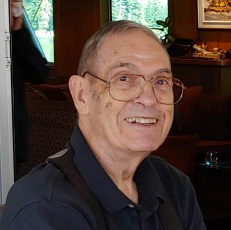
William Frisken, a professor emeritus in York University's Faculty of Science, passed away at the age of 90 on Aug. 8, after a major stroke.
Frisken, beloved husband, father, grandfather and colleague, was born in Hamilton, Ont., in 1933, and embarked on a life as an experimental high-energy particle physicist, environmental writer and researcher, university professor, amateur musician, maker of fine cherry bookshelves, home handyman and more.

Frisken began his career path towards becoming a prestigious particle physicist when he enrolled at Queen’s University in engineering physics in 1951, graduating in 1956. Shortly after, he worked for the Canadian General Electric Company on the prototype of the CANDU reactor, a heavy-water nuclear reactor used to generate electric power, before returning to Queen’s to work on a master’s degree, which he did by building an apparatus using two scintillation counters to study the angular correlation of nuclear gamma rays.
A graduate scholarship took him to Birmingham, England in the fall of 1957, where he and several colleagues built a bubble chamber (a recently designed piece of experimental equipment) and a “scattering table” using scintillation counters to study the mesons created by proton-proton scattering. After receiving his PhD in the summer of 1960, he and his wife, Frances Frisken, travelled back to Canada where he spent four years teaching physics at McGill University.
Next, Frisken moved to Long Island, N.Y., to work as an associate scientist at Brookhaven National Laboratory, then Cleveland, where he was appointed associate professor at Case Institute of Technology (soon to be amalgamated with Western Reserve University). During these years, he collaborated with physicists from several American universities on experiments that involved scattering short-lived elementary particles like pions and kaons from protons. The aim of these experiments was to help build a better understanding of the fundamental structure of the proton.
Upon returning to Canada again in 1971, Frisken was hired as a professor of physics at York University and went on to join the Institute of Particle Physics (IPP) to promote collaboration in particle physics research among Canadian universities. He became heavily involved in an IPP proposal to build a circular accelerator in which to collide high-energy electrons and protons. While the IPP first planned to develop this collider at the Fermilab in Chicago, the proposal eventually came to fruition as the Hadron-Electron Ring Accelerator (HERA) at the Deutsches Electronen-Synchrotron laboratory in Hamburg, Germany, making Frisken a key player in Canada becoming the first country in the world to support and contribute to HERA.
The IPP was also a major collaborator in the ZEUS experiment, carried out in the HERA collider, which began operation in 1995 and collected data until 2007. He was well known internationally by then for his expertise in designing and constructing unique particle detectors. For ZEUS, he spearheaded the development of a huge laboratory in Markham, Ont., where he and colleagues from McGill and the University of Toronto designed and built several tonnes of specialized calorimeters to measure the energies of particles scattered from HERA electron-proton collisions. These experiments contributed enormously to the understanding of the internal quark and gluon structure of the proton.
Frisken retired from York University in 1996 alongside his wife, Frances, a York professor emerita, who had been at the University as long as he had.
Frisken continued to pursue more physics after he retired, investigating superconducting radio frequency accelerator cavities, and gave his last scientific presentation in 2005. Many undergraduates, graduate students and postdoctoral fellows benefited from Frisken’s knowledge, and all of his colleagues greatly enjoyed the infectious wit with which he communicated his ideas. He is remembered by former colleagues as the designer and builder of state-of-the-art scientific equipment used to conduct experiments at the forefront of the field of elementary particle physics. He subscribed to the idea that “if you can buy the equipment you need for the experiment you plan, someone has probably already done it.”
Frisken wrote a biography of his life in physics, which can be found for free here: yorku.ca/science/physics/wp-content/uploads/sites/188/2021/10/W.Frisken-My-Life-in-Physics_Optimized.pdf
In lieu of flowers, donations can be made in Frisken’s memory to the Bruce Trail Conservancy or a charity of your choice.
